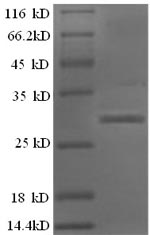Constructing a plasmid that codes for the human islet amyloid polypeptide protein (IAPP) protein (34-70aa) carrying the N-terminal GST-tag initiates the generation of the recombinant human IAPP protein. The constructed plasmid is transformed into E.coli cells. Positive E.coli cells are selected and then cultured under conditions that encourage the expression of the gene of interest. After that, affinity purification is employed to isolate and purify the recombinant IAPP protein from the cell lysate. The purity of the resulting recombinant IAPP protein is over 90%, determined by SDS-PAGE.
IAPP, also known as amylin, is released alongside insulin from pancreatic β-cells and helps regulate blood sugar levels [1]. In patients with type-2 diabetes, there's a buildup of this protein in the pancreas, forming what's known as islet amyloid [2]. Scientists believe that IAPP might play a role in how the body manages glucose and could be linked to the development of diabetes [3]. Since it's a protein that gets released, it's expected to be found in high amounts in the body [4]. When IAPP accumulates, it can interfere with normal bodily functions like how to process glucose and fats [5]. Some researchers also think that IAPP might be involved in the normal regulation of glucose and the onset of type 2 diabetes [6].
IAPP is made in pancreatic β-cells along with insulin [1]. Structurally, it's similar to another peptide called calcitonin gene-related peptide, which is involved in sensory functions [7]. Initially, IAPP is produced as a larger molecule called proIAPP and then processed inside the pancreatic cells' storage compartments [8]. Studies have shown that IAPP can disrupt autophagy, which is important for cell health, particularly in pancreatic β-cells. However, certain protective agents can help counteract this disruption [9]. Additionally, IAPP is known to form clumps called amyloids, and these clumps are found in about 90% of people with type 2 diabetes [10]. The buildup of these clumps is linked to the death of pancreatic β-cells in type 2 diabetes [11].
References:
[1] J. Sjölander, G. Westermark, E. Renström, & A. Blom, Islet amyloid polypeptide triggers limited complement activation and binds complement inhibitor c4b-binding protein, which enhances fibril formation, Molecular Immunology, vol. 48, no. 14, p. 1719, 2011. https://doi.org/10.1016/j.molimm.2011.06.389
[2] J. Höppener, C. Oosterwijk, S. Verbeek, K. Hulst, H. Visser, F. Hofhuiset al., Iapp/amylin transgenic mice as an in vivo modelsystem for type-2 diabetes mellitus?, Biochemical Society Transactions, vol. 21, no. 1, p. 28S-28S, 1993. https://doi.org/10.1042/bst021028s
[3] A. Clark, S. Chargé, M. Badman, D. MacArthur, & E. Koning, Islet amyloid polypeptide: actions and role in the pathogenesis of diabetes, Biochemical Society Transactions, vol. 24, no. 2, p. 594-599, 1996. https://doi.org/10.1042/bst0240594
[4] M. Birol, S. Kumar, E. Rhoades, & A. Miranker, Conformational switching within dynamic oligomers underpins toxic gain-of-function by diabetes-associated amyloid, Nature Communications, vol. 9, no. 1, 2018. https://doi.org/10.1038/s41467-018-03651-9
[5] X. Zou, H. Ouyang, T. Yu, X. Chen, D. Pang, X. Tanget al., Preparation of a new type 2 diabetic miniature pig model via the crispr/cas9 system, Cell Death and Disease, vol. 10, no. 11, 2019. https://doi.org/10.1038/s41419-019-2056-5
[6] P. Westermark, K. Johnson, T. O’Brien, & C. Betsholtz, Islet amyloid polypeptide ? a novel controversy in diabetes research, Diabetologia, vol. 35, no. 4, p. 297-303, 1992. https://doi.org/10.1007/bf00401195
[7] H. Mulder, A. Leckström, R. Uddman, E. Ekblad, P. Westermark, & F. Sundler, Islet amyloid polypeptide (amylin) is expressed in sensory neurons, Journal of Neuroscience, vol. 15, no. 11, p. 7625-7632, 1995. https://doi.org/10.1523/jneurosci.15-11-07625.1995
[8] F. Meng and D. Raleigh, Inhibition of glycosaminoglycan-mediated amyloid formation by islet amyloid polypeptide and proiapp processing intermediates, Journal of Molecular Biology, vol. 406, no. 3, p. 491-502, 2011. https://doi.org/10.1016/j.jmb.2010.12.028
[9] J. Rivera, T. Gurlo, M. Daval, C. Huang, A. Matveyenko, P. Butleret al., Human-iapp disrupts the autophagy/lysosomal pathway in pancreatic β-cells: protective role of p62-positive cytoplasmic inclusions, Cell Death and Differentiation, vol. 18, no. 3, p. 415-426, 2010. https://doi.org/10.1038/cdd.2010.111
[10] A. Raimundo, S. Ferreira, V. Pobre, M. Silva, J. Brito, D. Santoset al., Urolithin b: two-way attack on iapp proteotoxicity with implications for diabetes, Frontiers in Endocrinology, vol. 13, 2022. https://doi.org/10.3389/fendo.2022.1008418
[11] E. Pilkington, Y. Xing, B. Wang, A. Kakinen, M. Wang, T. Daviset al., Effects of protein corona on iapp amyloid aggregation, fibril remodelling, and cytotoxicity, Scientific Reports, vol. 7, no. 1, 2017. https://doi.org/10.1038/s41598-017-02597-0






